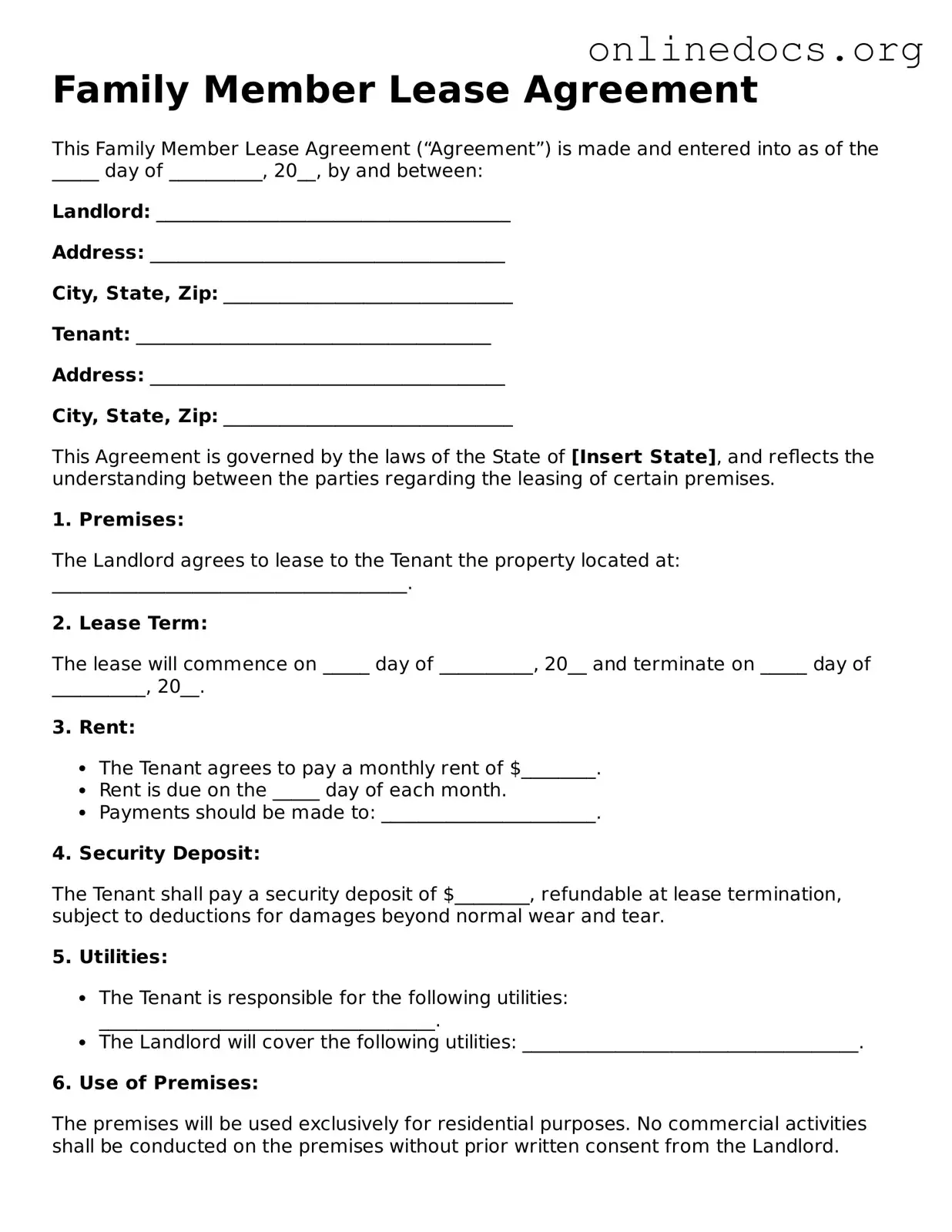The Family Member Lease Agreement form is similar to a standard Residential Lease Agreement. Both documents outline the terms and conditions under which a tenant can occupy a property. They typically include details such as the rental amount, duration of the lease, and responsibilities of both the landlord and tenant. However, the Family Member Lease Agreement often has a more personal touch, as it is intended for family members, which can influence the terms and the level of formality involved.
Another document comparable to the Family Member Lease Agreement is the Roommate Agreement. This document serves to clarify the expectations and responsibilities among individuals sharing a rental space. Like the Family Member Lease Agreement, it addresses issues such as rent payment, utility responsibilities, and house rules. However, a Roommate Agreement may be more focused on shared living arrangements rather than familial relationships.
The Sublease Agreement is another document that shares similarities with the Family Member Lease Agreement. This form allows a tenant to rent out their leased property to another individual. Both agreements require the original landlord's consent and specify terms like rent, duration, and responsibilities. However, a Sublease Agreement usually involves a third party, while the Family Member Lease Agreement is typically between family members and the primary tenant.
A Lease Extension Agreement is also relevant. This document is used when a tenant wishes to extend their stay beyond the original lease term. Similar to the Family Member Lease Agreement, it formalizes an ongoing relationship between the landlord and tenant. Both documents outline terms such as rent and duration, but a Lease Extension Agreement specifically focuses on extending an existing arrangement rather than establishing a new one.
The Rental Application form is another document that bears resemblance to the Family Member Lease Agreement. While the Family Member Lease Agreement formalizes the rental terms, the Rental Application is used to gather information about potential tenants. Both documents are essential in the leasing process, but they serve different purposes—one establishes the relationship, while the other assesses eligibility.
The Eviction Notice is a document that, while serving a different purpose, shares some structural similarities with the Family Member Lease Agreement. Both documents outline specific terms and conditions related to a rental arrangement. An Eviction Notice specifies the reasons for termination of the lease, while the Family Member Lease Agreement outlines the terms of occupancy. Both require clarity and adherence to legal standards.
The Family Member Lease Agreement is a vital document that not only establishes the terms and conditions of renting a property but also takes into account the personal relationship between the parties involved. Much like standard lease agreements, it includes essential details such as payment amounts and responsibilities, yet its nuances are specified to accommodate familial ties. For more information on lease agreements, refer to the following link: https://nypdfforms.com/lease-agreement-form.
The Lease Termination Agreement is also similar to the Family Member Lease Agreement. This document is used when both parties agree to end a lease before its expiration. Like the Family Member Lease Agreement, it details the responsibilities of both parties, including the return of security deposits and final payments. Both documents facilitate a smooth transition in the landlord-tenant relationship.
The Property Management Agreement is relevant as well. This document outlines the relationship between a property owner and a management company. Similar to the Family Member Lease Agreement, it includes terms regarding responsibilities, payments, and duration. However, the focus of a Property Management Agreement is on the management of the property rather than the rental relationship itself.
The Lease Purchase Agreement is another document that shares some characteristics with the Family Member Lease Agreement. This form allows a tenant to purchase the property they are renting after a specified period. Both agreements establish terms regarding payment and responsibilities. However, a Lease Purchase Agreement includes the added complexity of a potential sale, which is not typically present in a Family Member Lease Agreement.
Lastly, the Rent-to-Own Agreement is similar in that it allows tenants to rent a property with the option to buy it later. Both documents outline rental terms and conditions, but a Rent-to-Own Agreement typically involves additional clauses related to the purchase process. This makes it distinct, even as it shares foundational elements with the Family Member Lease Agreement.
